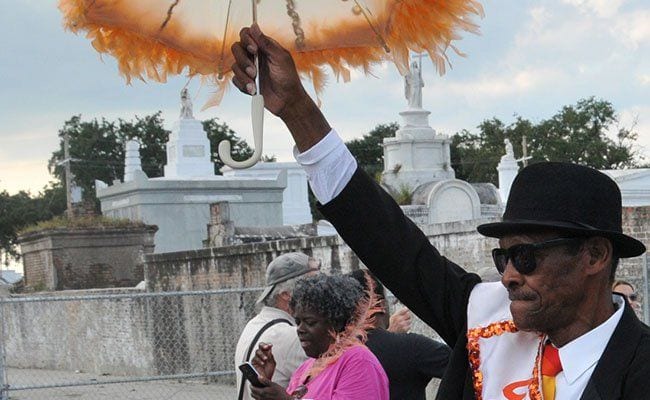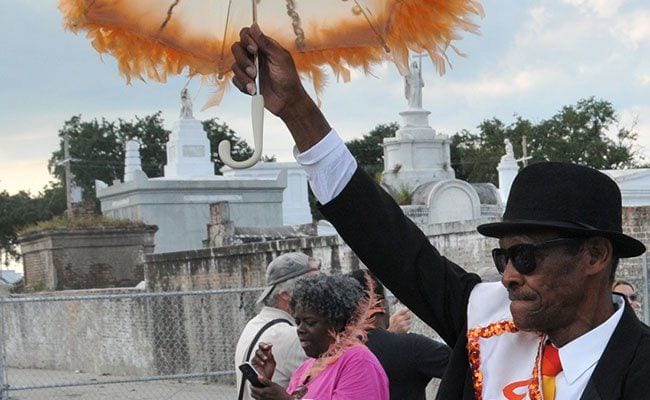
I survived Hurricane Katrina. This was the beginning of my second year in graduate school in Baton Rouge. My supply of batteries ran out long before the electricity came back on. The guy next door knocked one afternoon and we stood around on the catwalk in front of our blessedly second-story apartments picking at a plate of sliced nectarines that he’d brought over because they were about to go bad and he’d gotten tired of eating them alone. This was close enough to hear the announcer coming from Tiger Stadium on Sundays, yet I was the only white person in my apartment complex — save the building manager, naturally.
There are many ways to think about New Orleans “after Katrina”. For a long time, I would have to turn off the television if any kind of commemorative stuff was showing for the anniversary of one of the world’s deadliest and most destructive storms. Actually, I still have a fair amount of trouble looking at footage of any natural disaster involving bodies of water, be it a tsunami in Japan or flooded banks of the Mississippi. But at the end of a couple of weeks, nearly everybody’s lights came back on and we all went back to school — that’s a satisfying conclusion to a lucky white person’s version of the events of August 2005.
Richard Brent Turner’s impeccably updated new edition of Jazz Religion, the Second Line, and Black New Orleans after Katrina tells far more important stories than mine. I began to think immediately about the gap between the black and white experience in NOLA in the most productive and actionable terms, which can be illustrated with two memories I have about bones. Before or after the storm, trash in the gutter is common in the French Quarter. Tourists are drunk and show little respect for the people of New Orleans. I’ve stepped into a pile of discarded hot wings or similar detritus a dozen times while crossing Bourbon Street and never bothered to give the bones a second look. But on one occasion I heard that dull, familiar snap under my heel while crossing the stones in Congo Square and froze immediately in terror for my accidental offense. The bone was laid neatly across a preternaturally bright blue feather. I dropped to one knee, touched two fingers to my lips, then to the broken bone, then held them toward the sky.
A white person’s Quarter trash is sometimes a black person’s ancestral Vodou. Turner’s archival research and participatory observation of religious practices rooted in West or Central Africa and Haiti provides essential context for the second line activities in the Crescent City. “Second line” most directly refers to the group of celebrants in a procession that follow behind the “main line” of the band members and other people immediately relevant to the proceedings, such as the members of a club. Second line activities have a connection to music and dancing, such as at a jazz funeral or during Mardi Gras parades. These activities have a very long heritage, which Turner details as both a matter of street festivals and healing arts, in Louisiana and from the places whence Vodou came.
An entry point into this sound, for those not intimate with it already, might be Jon Batiste and Stay Human, the band on The Late Show with Stephen Colbert. His family has a storied musical lineage in New Orleans and Stay Human’s mission of spontaneous “love riot” street performances are undoubtedly shot through with the influences of Caribbean and African spiritual practices. Turner capably demystifies the racist stereotype of Vodou as malevolent sorcery stuck hopelessly in the past, but one of the best things about Jazz Religion is the way that it looks at what’s to come just as much as it looks at bygones.
I have seen and felt for myself how gloriously uplifting it is to bend and swing, slide and stomp, galloping down the street to follow the sounds of a Dirty Dozen or Rebirth outfit right to the water line. The culture of the second line has restorative power in the extreme. It’s healing the Lower Ninth and the Seventh. I’s an activist type of performance art, pushing up against the oversimplified pigeonhole of black masculinity. Before Katrina, the city was majority black. Before Katrina, the majority of blacks were employed. I live in Atlanta now, one of many cities hosting Katrina’s black diaspora. Louisiana remains the prison capital of the world.
Richard Brent Turner looks all of this in the eye. He’s unflinching, necessarily personal, properly professional, historically and culturally aware, and artfully academic. He worked at Xavier University for just four years, but the proof of his constancy to the Crescent City is evident in the thoroughness and polish of his prose, the diligence with which he fleshes out this strategy for future embodiments of hope and heritage.
Jazz Religion quickened my heart so many times. It certainly brought me back, but it also helped me to see a way forward from my own paralyzing slice of experience with Katrina. People who were there should read this book. People who were not there must read it.


![Call for Papers: All Things Reconsidered [MUSIC] May-August 2024](https://www.popmatters.com/wp-content/uploads/2024/04/all-things-reconsidered-call-music-may-2024-720x380.jpg)



